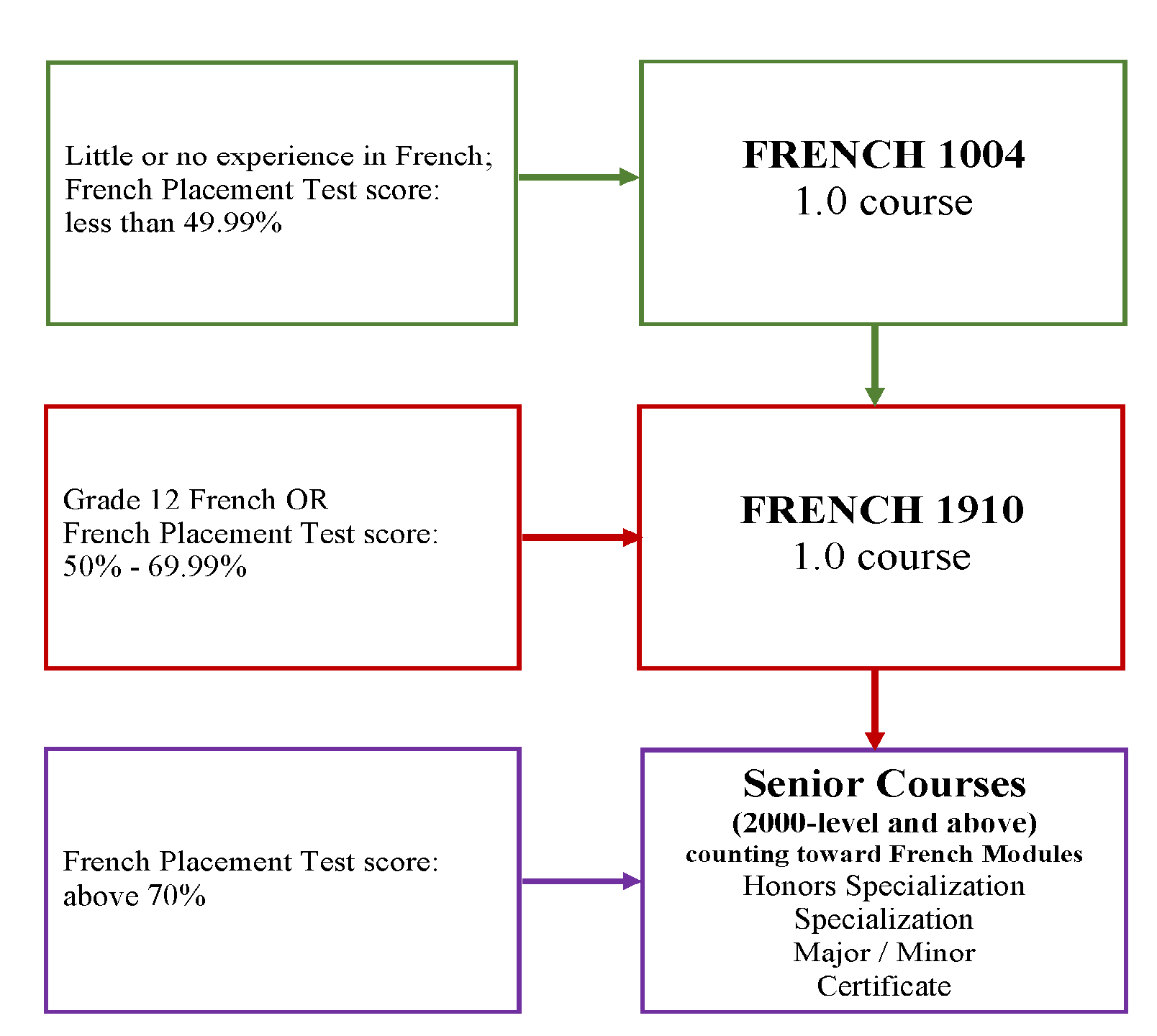French Courses at Western
The Department of French Studies offers a whole range of modules that can be added to your degree.
Check out our course offerings for this academic year!
How does it work?
The chart below can help you decide which course is right for you. (Download this information in PDF)

The University of Western Ontario offers a full series of French language courses, from pre-university level courses for beginners to advanced undergraduate courses.
Typically, university-level French courses offered on campus total about 100 hours of instruction in the classroom. Your French language classes will consist of 3 or 4 lecture hours per week. You are expected to come well-prepared to class and participate actively in all classroom activities. Grammar exercises, readings, and assigned exercises are to be completed at home on a weekly basis. On average, students are expected to spend at least 3 hours a week reviewing the material covered in class and preparing for the next class.
Attendance and class participation is key to the success of your learning experience in any course, and particularly in a language course. Attendance in all French language courses is mandatory. Your instructor will take attendance every class. For information about how to proceed if you miss a class, please consult the Academic Calendar.
The French courses at Western are designed with the CLB and CEFR guidelines in mind.
The Canadian Language Benchmarks (CLB)
The CLB are the national standard used in Canada for describing, measuring and recognizing the second language proficiency of adult immigrants and prospective immigrants for living and working in Canada. The Centre for Canadian Language Benchmarks promotes and supports the recognition and use of the CLB as a practical, fair and reliable national standard of second language proficiency in educational, training, community and workplace settings.
The CLB provide a descriptive scale of communicative proficiency in French as a Second Language, expressed as benchmarks or reference points. They cover four skill areas: reading, writing, speaking and listening, and use real life language tasks to measure language skills.
For more details, please visit the Centre for Canadian Language Benchmarks' website.
Common European Framework of Reference for Languages (CEFR)
The CEFR provides a basis for the mutual recognition of language qualifications, thus facilitating educational and occupational mobility. It provides a practical tool for setting clear standards to be attained at successive stages of learning and for evaluating outcomes in an internationally comparable manner.
For more details, please visit the Council of Europe's website.
Proficient User
C2 Can understand with ease virtually everything heard or read. Can summarise information from different spoken and written sources, reconstructing arguments and accounts in a coherent presentation. Can express him/herself spontaneously, very fluently and precisely, differentiating finer shades of meaning even in more complex situations.
C1 Can understand a wide range of demanding, longer texts, and recognise implicit meaning. Can express him/herself fluently and spontaneously without much obvious searching for expressions. Can use language flexibly and effectively for social, academic and professional purposes. Can produce clear, well-structured, detailed text on complex subjects, showing controlled use of organisational patterns, connectors and cohesive devices.
Independent User
B2 Can understand the main ideas of complex text on both concrete and abstract topics, including technical discussions in his/her field of specialisation. Can interact with a degree of fluency and spontaneity that makes regular interaction with native speakers quite possible without strain for either party. Can produce clear, detailed text on a wide range of subjects and explain a viewpoint on a topical issue giving the advantages and disadvantages of various options.
B1 Can understand the main points of clear standard input on familiar matters regularly encountered in work, school, leisure, etc. Can deal with most situations likely to arise whilst travelling in an area where the language is spoken. Can produce simple connected text on topics, which are familiar, or of personal interest. Can describe experiences and events, dreams, hopes & ambitions and briefly give reasons and explanations for opinions and plans.
Basic User
A2 Can understand sentences and frequently used expressions related to areas of most immediate relevance (e.g. very basic personal and family information, shopping, local geography, employment). Can communicate in simple and routine tasks requiring a simple and direct exchange of information on familiar and routine matters. Can describe in simple terms aspects of his/her background, immediate environment and matters in areas of immediate need.
A1 Can understand and use familiar everyday expressions and very basic phrases aimed at the satisfaction of needs of a concrete type. Can introduce him/herself and others and can ask and answer questions about personal details such as where he/she lives, people he/she knows and things he/she has. Can interact in a simple way provided the other person talks slowly and clearly and is prepared to help.




